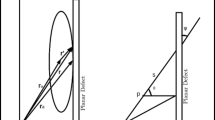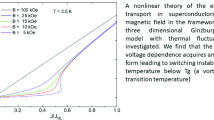Abstract
We consider a time-dependent Ginzburg-Landau (TDGL) model modified to take into account two mechanisms responsible for the Hall voltage in superconductors: the usual effect of the magnetic field on the normal current, and the vortex traction by the superflow. For the BCS model of superconductivity, the contribution of the vortex traction is proportional to the energy derivative of the quasiparticle density of states. Our theory gives the correct order of magnitude for the Hall angle in the mixed state. It predicts that the vortex-traction mechanism results in a negative Hall angle for the quasiparticle spectrum with a positive energy derivative of the density of states averaged over the Fermi surface, and vice versa. For the Fermi surface with a complicated shape, the sign of the Hall effect in the mixed state can be different from that in the normal state. If the signs are opposite, the Hall angle changes its sign as a function of the magnetic field belowH c2 .
Similar content being viewed by others
References
S. J. Hagen, C. J. Lobb, R. L. Greene, M. G. Forrester, and J. H. Kang,Phys. Rev. B 41, 11630 (1990).
M. A. González, P. Prieto, D. Oyola, and J. L. Vicent,Physica C 180, 220 (1991).
S. J. Hagen, C. J. Lobb, R. L. Greene and M. Eddy,Phys. Rev. B 43, 6246 (1991).
J. Luo, T. P. Orlando, J. M. Graybeal, X. D. Wu, and R. Muenchausen.Phys. Rev. Lett. 68, 690 (1992).
Z. D. Wang and C. S. Ting,Phys. Rev. Lett. 67, 3618 (1991).
R. A. Ferrell,Phys. Rev. Lett. 68, 2524 (1992).
K. Noto, S. Shinzawa and Y. Muto,Solid State Commun. 18, 1081 (1976).
J. Bardeen and M. J. Stephen,Phys. Rev. 140A, 1197 (1965).
P. Nozières and W. F. Vinen,Philos. Mag. 14, 667 (1966).
N. B. Kopnin and V. E. Kravtsov,Pis'ma Zh. Eksp. Teor. Fiz. 23, 631 (1976) [JETP Lett. 23, 578 (1967)].
N. B. Kopnin and V. E. Kravtsov,Zh. Eksp. Teor. Fiz. 71, 1644 (1976) [Sov. Phys. JETP 44, 861 (1976)].
N. B. Kopnin and M. M. Salomaa,Phys. Rev. B 44, 9667 (1991).
H. Ebisawa,J. Low Temp. Phys. 9, 11 (1972).
G. M. Eliashberg,Zh. Eksp. Teor. Fiz. 61, 1254 (1971) [Sov. Phys. JETP 34, 668 (1972)].
L. P. Gor'kov and N. B. Kopnin,Usp. Fiz. Nauk 116, 413 (1975) [Sov. Phys. Usp. 18, 496 (1976)].
I. A. Larkin and Y. N. Ovchinnikov, inNonequilibrium Superconductivity, D. N. Langenberg and A. I. Larkin, eds. (Elsevier, New York, 1986), p. 493.
K. Maki,Progr. Theor. Phys. 41, 902 (1969).
A. A. Abrikosov,Zh. Eksp. Teor. Fiz. 32, 1442 (1957) [Sov. Phys. JETP 5, 1174 (1957)].
M. Yu. Kuprijanov and K. K. Likharev,Pis'ma Zh. Eksp. Teor. Fiz. 15, 349 (1972).
B. I. Ivlev and N. B. Kopnin,Europhys. Lett. 15, 349 (1991).
L. P. Gor'kov and G. M. Eliashberg,Zh. Eksp. Teor. Fiz. 54, 612 (1968) [Sov. Phys. JETP 27, 328 (1968)].
A. A. Abrikosov and L. P. Gor'kov,Zh. Eksp. Teor. Fiz. 39, 1781 (1960) [Sov. Phys. JETP 12, 1243 (1960)].
A. K. Niessen, F. A. Staas, and C. H. Weijsenfeld,Phys. Lett. 25A, 33 (1967).
A. T. Dorsey,Phys. Rev. B 46, 8376 (1992).
Author information
Authors and Affiliations
Rights and permissions
About this article
Cite this article
Kopnin, N.B., Ivlev, B.I. & Kalatsky, V.A. The flux-flow hall effect in type II superconductors. An explanation of the sign reversal. J Low Temp Phys 90, 1–13 (1993). https://doi.org/10.1007/BF00682008
Received:
Issue Date:
DOI: https://doi.org/10.1007/BF00682008




